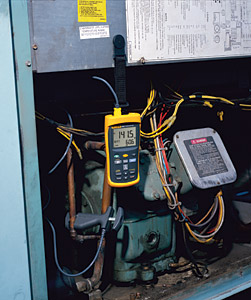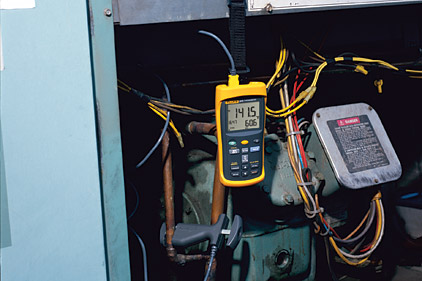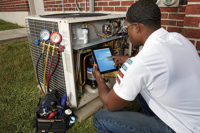
|
| Having the proper test and measurement equipment should be on every HVAC service technician’s to-do list when troubleshooting compressors. |
Some people say that the compressor is the key component, or heart, of an air conditioning system. And like the human heart, the compressor must be kept in tip-top condition to run the system efficiently.
Both “organs” are difficult to maintain directly, since the heart is inside the body and the compressor, for the most part, is hermetically sealed. Like the human heart, the compressor depends on many parts connected to it. Circuits that carry electric current and airflow are vital to the compressor just like veins that carry blood are vital to the heart. And an overworked compressor, like a heart, will eventually wear out.
“Compressors don’t die, they are killed,” said Dave Williams of Cypress Creek Air Conditioning, Houston. “We try to find out what caused the failure such as low airflow, component mismatch, lack of maintenance, etc.”
According to Isaac Sepulveda of Indoor Comfort Inc., Lynwood, Calif., “The principal compressor failure is caused by a dirty condenser. If the temperature rises, pressure will rise. And if the condenser is dirty the pressure will rise three times the normal condition. Finally, the compressor will consume more amperes and overheat until it burns out.”
Troubleshooting Tips
So what are the best ways to maintain a healthy compressor? A number of HVAC contractors suggested several troubleshooting tips for proper compressor maintenance.
According to Don Bowen of Bowen Heating, Cooling and Refrigeration, Muskegon, Mich., there are two ways to prolong the life of a compressor.
“I believe the things that need to be addressed are keeping your condenser coil clean and checking superheat settings,” he said. “A dirty condenser will cause higher than normal head pressures, which creates heat and will cause your saturated suction temperatures to be warm, causing compressor failure.
“Also, superheat is a huge factor in compressor failure. Too high of superheat will also cause your saturated suction temperature to be too warm and too low of superheat may cause liquid flooding — which is bad for the compressor.”
Troubleshooting can be pretty simple and straightforward according to Carmine Galletta of Gallettair Inc., West Babylon, N.Y. “Depending upon the type of compressor in your equipment maintenance — semi-hermetic or hermetic — maintenance procedures will vary. Semi-hermetic compressors are sealed so realistically there is no internal maintenance that can be performed, other than being certain that the refrigerant pressures are at the proper charge levels, the compressor terminals are secured, and the compressor connections are also secured at the contactor locations.
“Start and run amps should be checked to determine if the compressor is drawing the proper amperage upon start. When performing routine maintenance and if there are signs of oil leakage from a refrigerant leak that was repaired, you may consider adding some refrigerant oil to the compressor crankcase. And checking the start capacitor or start assist kit for the compressor should also be part of routine maintenance.”
Maintenance Tips
Two areas that contractors emphasize most are maintaining proper electrical current and clean components. Travis Seeger of Chesterfield Service, St. Louis, has advice about testing electrical integrity.
“If using a megohmmeter to test windings, the unit must have run in the recent past,” he said. “If the unit has sat all night on a cool morning it could be sitting there with liquid refrigerant well into the windings and therefore cause strange or fail-type readings. Secondly, if you have any question of readings and you are not at the compressor terminals, get to them to take the readings — and before you go and pull those wires off, carefully inspect the terminals and the surroundings for any burn or fatigue signs. If an area is showing signs of terminal failure or burns, proceed with extreme caution.
“We also do quite a bit of unloading scroll and multi-compressor units. The unloading scroll compressors are fairly easy to diagnose for staging, with the unit running and gauges installed, the low voltage (diode) can be connected and disconnected to determine if the unit is bouncing in and out of stages properly.”
Phillip Sterling of A/C Today, Dallas, listed 12 things to look for and do when troubleshooting and maintaining a healthy compressor:
1. Proper refrigerant charge
2. Low pressure switch (low charge cutoff)
3. High pressure switch (fan failure)
4. Keep condensing coils clean
5. Contactor should be replaced if burnt (if contacts weld, the compressor will run continuously until it dies)
6. Clean air filter
7. Return air matched for tonnage
8. Run cap checked (too small or too large will shorten the life of the compressor)
9. Hard start kit for starting removes damage to internal windings
10. Compressor matched to indoor (if it’s larger, than the tech will overcharge the compressor to get the suction pressure up so it will not freeze up)
11. Suction drier
12. Accumulator
Mark Johnson of Comfort Air Service LLC, Easton, Md., added a few more suggestions. “Check the capacitor, superheat, subcooling, crankcase heater, contactor voltage drop, and the disconnect condition,” he said.
Frank Raimondi of United Cooling & Refrigeration, Roselle, N.J., had some other advice, too. “Lubrication is probably the most important thing,” he said. “Have enough oil and make sure the system is not flooding back and diluting the oil. Test the oil safety control if there is one by verifying the pressure setting and checking the timing.”
Dave Williams said there is another important key to troubleshooting compressors — well-trained technicians. “Having educated technicians (all NATE certified) that understand the relationship between the different components, temperatures and use of instruments, (e.g., what should the correct amp draw of a compressor be) is very important,” he said.
Tool Tips
Having the right tools is critical, too. “Measure compressor winding insulation integrity using a megohmmeter,” Williams said. “We find this to be a great diagnostic tool to alert owners of potential failures on the next hot day.”
Reading and understanding the manufacturer’s data can also go a long way to properly diagnosing a compressor problem, according to Kevin Westcott of Family Plumbing, Heating & Air Conditioning, Gaylord, Mich. “Measure refrigerant pressures and compare them to factory data,” he said. “Unfortunately, in many cases the technician will use a rule of thumb for this. With all the changes over the past 10 years, the only way to do this is with the data for that specific unit.
“And remember, all measurements need to be done with an instrument. Your hand is not a thermometer. It ‘feels cold’ is not correct data.”
“Most residential and light commercial compressors are non-maintainable hermetically sealed devices,” said Huge Joyce of James River Heating and Air Conditioning, Richmond, Va.
“With that being said, the only maintenance I can suggest is anything that keeps proper airflow through the system so that the refrigerant process works correctly, protecting the compressor, and maintaining efficiency.”
Publication date: 03/26/2012







